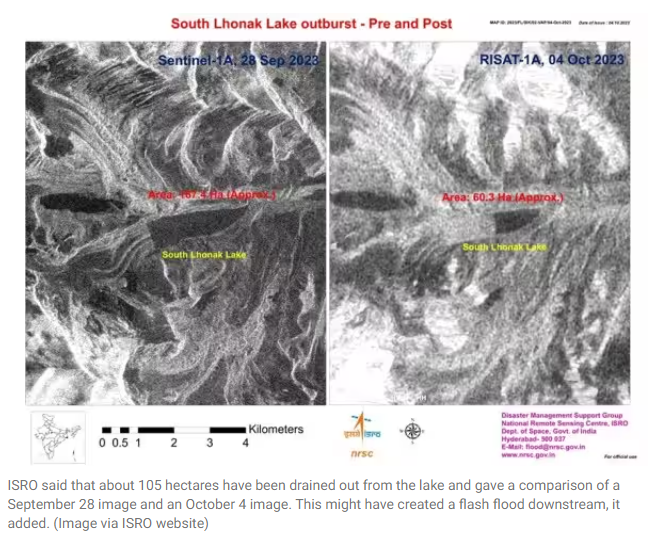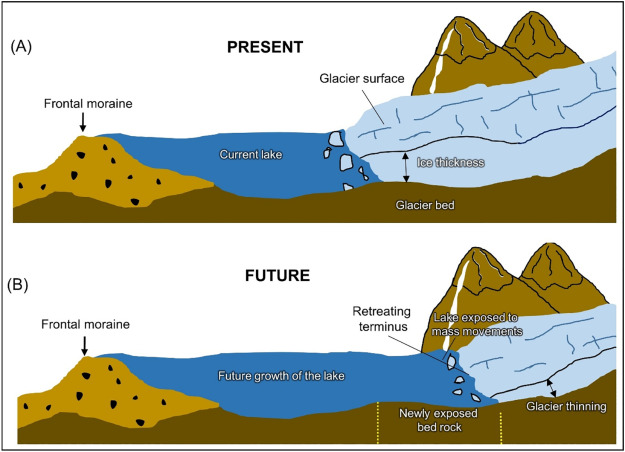ForumIAS announcing GS Foundation Program for UPSC CSE 2025-26 from 19 April. Click Here for more information.
ForumIAS Answer Writing Focus Group (AWFG) for Mains 2024 commencing from 24th June 2024. The Entrance Test for the program will be held on 28th April 2024 at 9 AM. To know more about the program visit: https://forumias.com/blog/awfg2024
Contents
| For 7PM Editorial Archives click HERE → |
Recently, Glacial lake Outburst flood(GLOF) has caused heavy destruction in Sikkim. South Lhonak Lake- which is a glacial lake situated in north western Sikkim at 17,000 ft- burst due to incessant rains. This led to release of large volume of water in downstream areas. It caused a rise in the water levels of Teesta river that flooded the four districts of Mangan, Gangtok, Pakyong and Namchi of Sikkim. Atleast Fourteen people have been killed and 102 people (including at least 23 Army personnel) are missing due to this disaster.

What is Glacial Lake Outburst Flood(GLOF)?
Glacial Lakes- Glacial lakes, like the South Lhonak Lake, are large bodies of water that sit in front or on top or beneath a melting glacier. These glacial lakes are mostly dammed by unstable ice or sediment composed of loose rock and debris.
Glacial Lake Outburst Flood (GLOF)- As the glacial lakes grow larger, they become more dangerous because they are dammed by unstable ice or sediments composed of loose rock and debris. When the boundary around these glacial lakes breaks, huge amounts of water rush down the side of the mountains, which causes flooding in the downstream areas. This is called glacial lake outburst floods or GLOF.

Some Examples of GLOF in India- 1.Uttarakhand Kedarnath Flash Flood 2013 induced by GLOF in the Chorabari Tal glacial lake. 2. GLOF in Uttarakhand Chamoli District in the Nanda Devi Glacier.
Read More- GLOF Forum IAS
What are the reasons for the Glacial Lake Outburst Flood(GLOF)?
The reasons for the Glacial Lake Outburst Flood(GLOF) are mentioned below.
Melting of Glaciers- Rapid melting of glaciers due to rising global temperature is increasing water level in the glacial lake. The increase in the volume of water puts pressure on the boundary of the glacial lake which consists of unstable ice and rubbles. The breaking of these natural boundaries lead to glacial lake outburst floods.
Avalanches and Earthquakes- Landslides or ice avalanches in the area near glacial lakes displace large volumes of water. This large volume of displaced water breaches the natural dams resulting in GLOF.
Extreme Meteorological Conditions- Heavy rainfall, extreme storms and sudden temperature changes can influence the stability of glacial lakes and trigger GLOF.
Climate Change Impact- The Himalayan-Hindukush region is a climate change hotspot region. Accelerated glacier melting leads to the formation of glacial lakes. These have increased the GLOFs in the Himalayan region. Climate change has also increased the frequency and intensity of cloudbursts leading to GLOF.
Volcanic Activities- Volcanic activities near the glacial regions of the world can increase the chances of GLOF due to melting of the glaciers.
Susceptibility of Moraine embankments- Moraines and piles of debris carried by glaciers act as natural barriers of the glacial lakes. However these moraines which act as dams of the glacial lakes are susceptible to breaching leading to GLOF.
Anthropogenic Reasons- Modern infrastructure like dams and roads in the mountaneous regions intensify geological stresses which have led to GLOF like the Chamoli GLOF 2021 due to multiple hydro power projects.
| Reasons for the Vulnerabilities of the Himalayan Region to GLOF The Himalayan states of India like Uttarakhand, Sikkim, Himachal Pradesh are vulnerable to GLOF. 1. Out of the 8800 glaciers present in the Himalayan region, 200 glaciers have been classified as dangerous, which can trigger the Glacial outburst. 2.According to the Hindu Kush Himalayan Assessment report, one-third of the region’s glaciers would melt leading to increased GLOF. 3.The Indian plate is continuously moving towards north about 2 cm every year. So the Himalayas is rising about 5 mm a year. This makes the Himalayan region geologically active and structurally unstable. Landslides and earthquake are regular features here triggering glacial outburst floods. 4. The large human settlements and human activities have resulted in large scale deforestation. This intensifies the GLOF, as there is no natural barrier to control the flood. |
What are the Impacts of Glacial lake of Outburst Flood(GLOF)?
GLOF have large negative impacts which breaks the back of economy and the country.
Loss of life- GLOF are deadly events which cause loss of life for those living in the affected area. People are caught off guard and there is not enough time to evacuate or prepare for the flood.
Infrastructural damage- The high volume and force of water released during a GLOF causes significant damage to infrastructure such as roads, bridges, buildings, and power plants. This leads to severe economic losses and long term disruption of essential services.
Agricultural damage- GLOF damage agricultural land, crops and livestock leading to food shortages and loss of income for farmers. These also have long-term effects on the local economy and pose challenges to food security.
Environmental damage- GLOF causes heavy destruction of biodiversity in the areas of its occurrence with heavy destruction of flora and fauna.
What should be the Way Forward?
Natural Disasters are difficult to stop. But mitigating the impacts of theses disasters is in our hands. Thus NDMA has realised its guidelines for prevention from the negative impacts of Glacial Lake Outburst Flood which must be followed in letter and spirit.
Identification of Potentially Dangerous Lakes- Potentially dangerous lakes must be identified based on field observations, records of past events, geomorphologic and geotechnical characteristics of the lake/dam and surroundings. This will help us in preparing our development plan near these potentially dangerous lakes.
Increased Use of Technology- Promotion of use of Synthetic-Aperture Radar imagery (a form of radar that is used to create two-dimensional images) to automatically detect changes in water bodies, including new lake formations, during the monsoon months.
Channel out Potential Floods- Reducing the volume of water in the glacial lakes with methods such as controlled breaching, pumping or siphoning out water and making a tunnel through the moraine barrier or under an ice dam.
Enhancement of Early Warning Systems (EWS)- The number of deployed Early Warning Systems must be increased in the Himalayan region for effective mitigation of damage from the GLOF.
Comprehensive Alarm Systems- Modern communication technology using smartphones must complement the traditional alarming infrastructure of acoustic alarms. This will help in early evacuation in case of danger.
Development of Uniform Codes for Construction Activity- We must developing a broad framework for infrastructure development, construction and excavation in vulnerable zones.
We must develop procedures for land use planning in the GLOF prone areas.
Training of Local Manpower- Apart from the specialised forces such as National Disaster Response Force (NDRF), ITBP and the Army, NDMA has emphasised on the need for training local manpower. It has been observed that over 80% of search and rescue is carried out by the local community before the intervention of the state machinery and specialised search and rescue teams.
Read More- Indian Express




